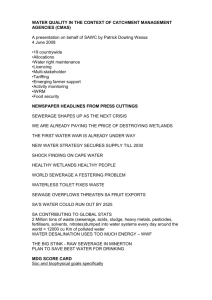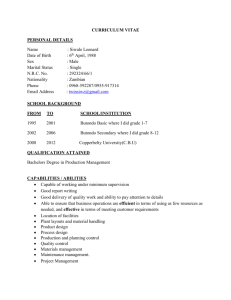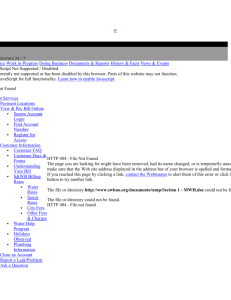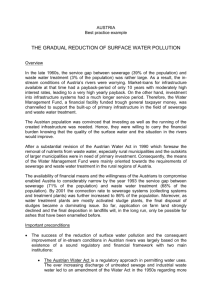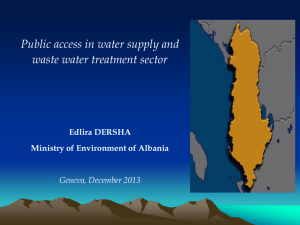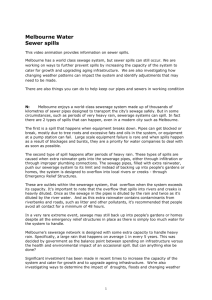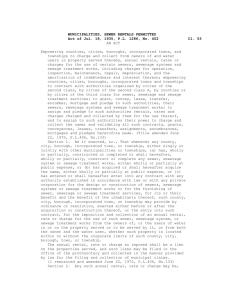Definition of sewerage system
advertisement
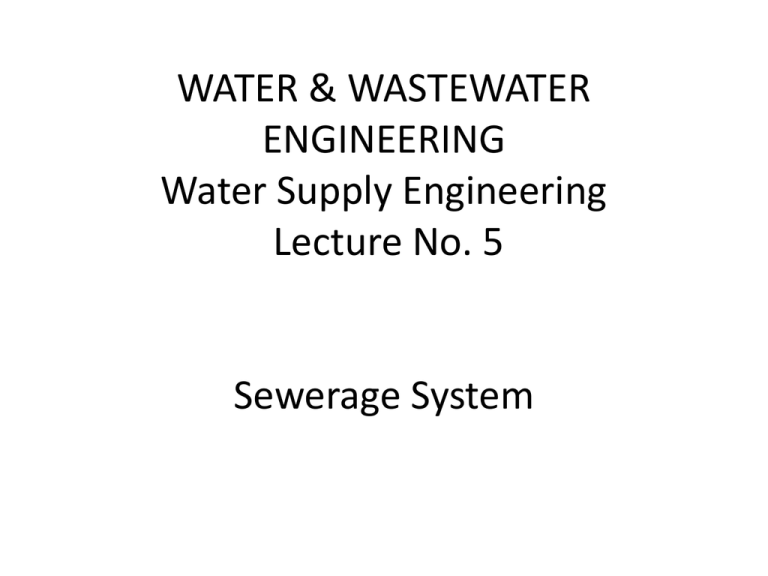
WATER & WASTEWATER ENGINEERING Water Supply Engineering Lecture No. 5 Sewerage System Sewerage System Wastewater Works • Collection Works (Sewage Network) • Treatment Works(Wastewater treatment plant) • Final Disposal works( of treated ww and sludge) Sewerage System • The objectives of WW works(projects) Protecting the environment with all its components from pollution due to untreated ww. • Protecting public health from disease spreading. • Protecting buildings and infrastructures • Re-use of treated ww . Sewerage System • Definitions A wastewater project is generally designed and constructed to serve the community for a number of years in the future. • Initial Year: is the year when the construction of the project is completed and the initial operation begins. • Design or planning year: is the year when the facility is excepted to reach its full design capacity and further expansion may become necessary. Sewerage System • Data to be collected for a WW project for a certain city o Maps and layout of the city. o City’s topography o To estimate ww discharges: • Present population, population’s growth rates and trends. • Design period • Per capita water consumption o Climate Conditions • Rain intensity • Prevailing wind direction o Data about depth of GWT and soil type. o Type of surfaces in the city and their percent of the total city’s area. Sewerage System General Considerations in Planning and Design of Sewerage Networks • Sewers’ slope should follow the natural ground slope whenever possible to decrease the pipes’ depth. • This is why , pump stations are usually in the lowest parts of the service area. • Make sure that all the area is served with the network. • Avoid U-path. • WWTP should be down wind. Sewerage System • Definition of sewerage system: It is a complete system to collect wastewater consist of a gravity sewer network , pump station , force main. Sewerage System Collection Treatment distribution loop system - hardy cross method - section method - circle method Sewerage System • Force Main: مثل ماسورة مياه الشرب و لكن تكون مغطاه من الداخل بمواد تحميها من تفاعالت المواد الموجودة بمياه الصرف. Sewerage System • Kinds of pipe material used in sewerage system: 1- vitrified clay 2- DCI 3- UPVC 4- P.E 5- R.C نراعي عند اختيار نوع الماسورة: -1التكلفة -2نوع التربة :يبين تقرير التربة مدي عدوانية التربة فاذا كانت التربة عدوانية يفضل عمل الحماية الكاثودية و ال يفضل استخدام مواسير حديدية في اماكن احتمال حدوث تيارات شاردة. Sewerage System • Commercial Diameters Commercial Diameters for vitrified clay pipes 175, 225, 300, 375, 400, 450, 500, 600, 700, 800, 900, 1000 mm. Commercial Diameters for uPVC pipes 150, 200, 250, 300, 350, 500, 600, 700, 800, 1000 mm. Sewerage System • Components of WW Flows • Domestic ww : it includes ww from residential, commercial, small industry, and public facilities. • Industrial ww: ww in which industrial wastes predominates. • Infiltration Water: water that enters the sewer system through leaking joints, cracks and breaks, or porous walls. • Rain Water( storm water): runoff resulting from rainfall. Sewerage System Factors affecting Domestic WW discharges • Community size • Standard of living and population’s activities. • Climate conditions . • Quality of water. • Price of water. • Metered services Sewerage System Factors Affecting Industrial WW discharges • Type of industry and the resulting organic loads. • Working hours. • Water consumption rates. Sewerage System Factors affecting Infiltration Water discharge • Sewers' diameters. • Sewers’ pipe material. • Sewers’ depth. • Sewers’ length below GWT. • Type of connections. Sewerage System • The flow velocity in the sewers should be such that the suspended materials in sewage do not get silted up; i.e. the velocity should be such as to cause automatic self cleansing effect. The generation of such a minimum self cleansing velocity(0.6m/s) in the sewer, at least once a day, is important, because if certain deposition takes place and is not removed, it will obstruct free flow, causing further deposition and finally leading to the complete blocking of the sewer. Sewerage System • The smooth interior surface of a sewer pipe gets scoured due to continuous abrasion caused by the suspended solids present in sewage. It is, therefore, necessary to limit the maximum velocity in the sewer pipe. This is called limiting or non-scouring velocity ( < 1.5m/s) Sewerage System Combined and Separate Sewers • Combined sewers is a single pipe network that carries a mixture of ww and rain water and conveys it to the WWTP, while separate sewers are two separate networks : one intended to carry ww while the other is for rain water. Rain water is disposed off in a nearby water body(usually the sea in coastal areas). Sewerage System • Separate sewers are used in cities where rain intensity is high as in Alexandria, Egypt. This is done in order to avoid increasing the amount of ww to be treated at the WWTP . Its main disadvantage is the high cost due to construction of two networks. • Combined sewers are used where the rain intensity is low. Its main disadvantage is the increased ww discharge to the WWTP with a rain water flow that doesn’t require treatment. 12 Sewerage System COMBINED SYSTEM • the streets are narrow •The quantities of rain water are small •The land is flat and sewage is concentrated and dilution with rain water is being a method of treatment SEPARATE SYSTEM • the streets are wide and there is a space for two sewers lines •Rainwater is higher than sewage from the remaining sources •Treatment of sewage is expensive Sewerage System Pipes are designed partially full for the following reasons. • Aeration: as ww is to be treated aerobically in WWTP . • To meet daily, seasonally and future variations in ww flows. Sewerage System • ½ full 2/3 full ¾ full Sewerage System Manholes Manholes are concrete chambers (circular, square or rectangular) which has an opening and a cover, constructed on sewers network for maintenance and aeration purposes. • 1. 2. 3. 4. 5. 6. Location of manholes At the intersections between two sewers. At any house connection. At the change in slope. At change in size. At change of direction. In straight sewers there is max spacing between manholes to permit inspection and cleaning of sewers
